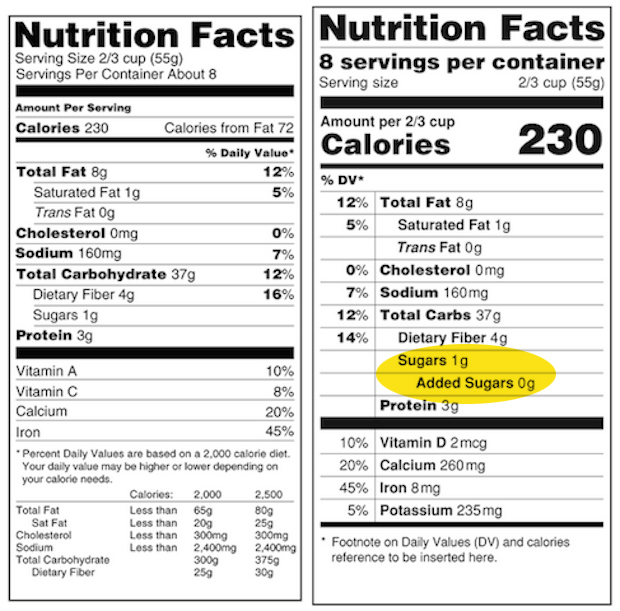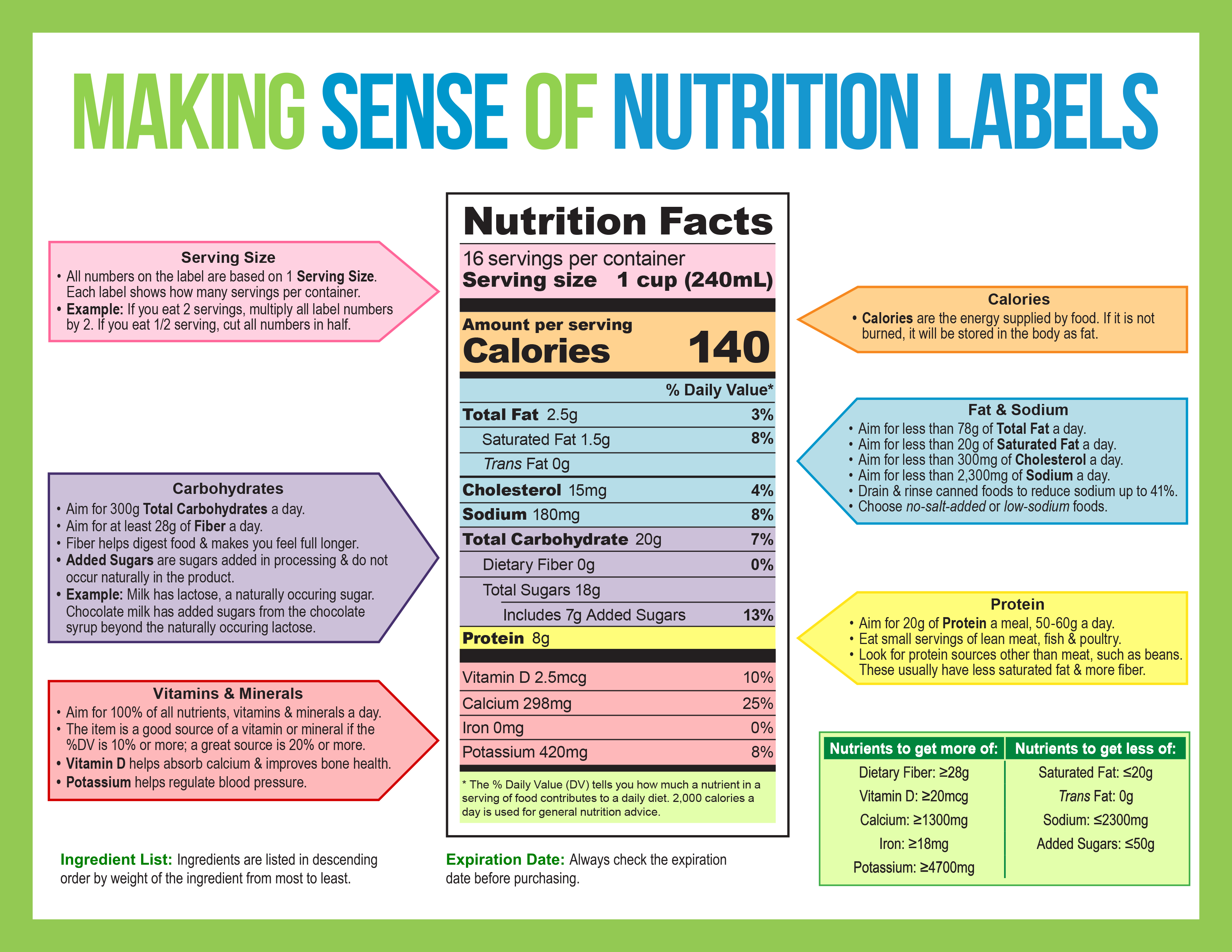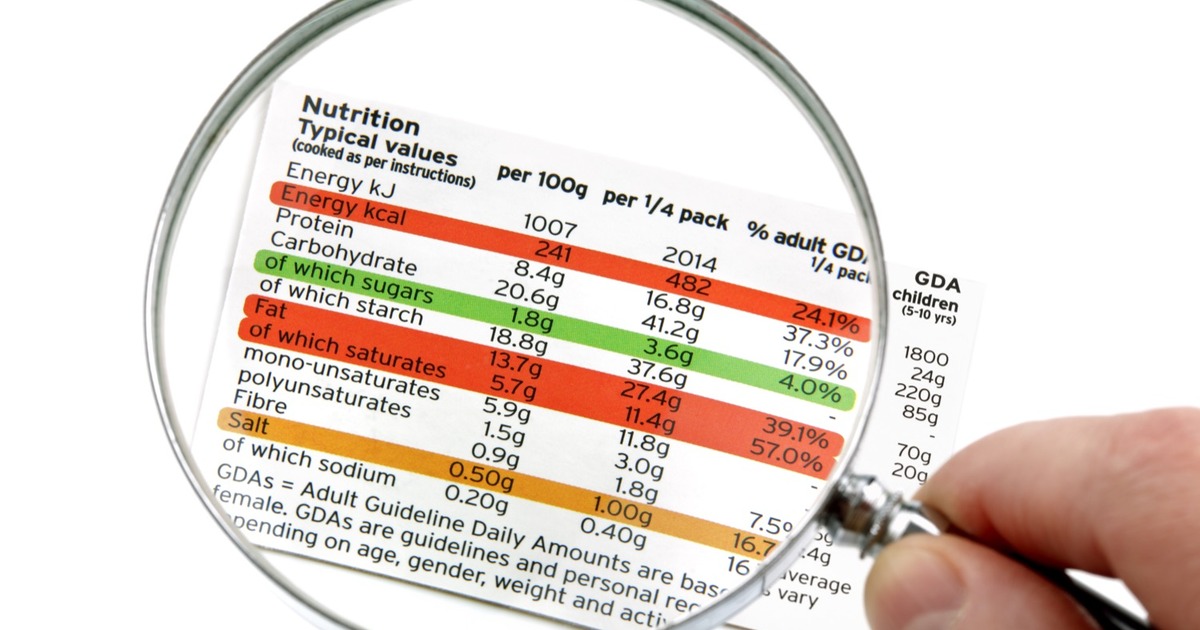38 daily values on food labels
Daily Values (DVs) - National Institutes of Health Recommended intakes of nutrients vary by age and sex and are known as Recommended Dietary Allowances (RDAs) and Adequate Intakes (AIs). However, one value for each nutrient, known as the Daily Value (DV), is selected for the labels of dietary supplements and foods. A DV is often, but not always, similar to one's RDA or AI for that nutrient. Daily Value on the New Nutrition and Supplement Facts ... New Daily Values (1) Indicates a unit of measure change. The unit of measure is how a vitamin or mineral is measured, so the %DV may look different. (2) The Daily Value decrease for folate/folic...
Daily Value: Definition and How to Calculate It - Insider Found on the nutrition label, the daily value system tells you can help you determine if a product is high or low in particular nutrients. What does daily value mean? Daily value (DV) refers to how much of a nutrient you should consume each day based on a 2,000 calorie diet. You can find daily values for a range of nutrients on the FDA's website.

Daily values on food labels
The Basics of the Nutrition Facts Label A food item with a 5% DV of fat provides 5% of the total fat that a person who needs 2,000 calories a day should eat. You may need more or less than 2,000 calories per day. This means that you may need more or less than 100% DV that is listed on the package for some nutrients. Low is 5% or less. Table of Daily Values - Canada.ca This document is a two-part table that sets out the recommended amounts of nutrients (the daily value) for specific age groups. These are the reference points upon which the % daily value in the nutrition facts table are based. Part 1 of the table sets out the daily values for macronutrients and sodium for two age groups. the % daily values found on a food label are based on ... The question is asking what the the % daily values found on a food label are based on. Those values give us the information for example that some food is 30% of necessary daily calories or that it covers 30% of the need for Vitamin C. This is based on the needs of an average adult person, who needs to consume 2000 calories a day.
Daily values on food labels. Percent daily value - Canada.ca dividing the amount of a nutrient in a serving size by its daily value, then multiplying that number by 100 For example, a food product has 3 mg of iron. The daily value for iron is 14 mg. This means that the % DV for iron would be 21%. If you would like to do your own calculation, use the equation below to help you. (3 mg ÷ 14 mg) × 100 = 21% DV How you can Calculate % of Daily Value on Food Labels ... How to Calculate % of Daily Value on Food Labels. Step 1. Find the nutrient amount on the food label. Step 2. Look up the total daily recommended amount in the USDA Dietary Guidelines. Step 3. Divide the nutrient amount by the total daily recommended value. Step 4. How To Read Food and Beverage Labels | National Institute ... The percent Daily Value (% DV) tells how much a nutrient in a serving of the food or beverage contributes to a total daily 2,000-calorie diet. Although the average person needs 2,000 calories a day to maintain their weight, individuals may need more or fewer depending on their lifestyle. Percent Daily Value On Food Label - LabelCal What are Percent Daily Values on Food Labels? Percent daily values represent the percentage of the recommended daily intake a single serving of food contains. For instance, if the percent daily value for saturated fat is 45%, that means you are getting almost half of the saturated fat that the FDA recommends you consume in one day.
A Guide to Reading Food Labels - University of Rochester Feb 27, 2013 · Understanding the Percent Daily Values (% DV) on a food label can help you choose foods high in good nutrients and low in bad nutrients. The % DV is based on a 2,000-calorie diet. If you eat less than 2,000 calories a day, your daily value may be lower than what is listed on the label. If you eat more than 2,000 calories a day, your daily value The Vegetarian Resource Group Blog - VRG Daily values are amounts of nutrients that people are recommended to consume or not to exceed each day. The Daily Value may be somewhat different from the amount of a nutrient you need. For example, the RDA for calcium for adults ranges from 1,000 milligrams for younger adults to 1,300 milligrams for pregnant and lactating women. The Lows and Highs of Percent Daily Value on the Label The percent Daily Value (%DV) shows how much a nutrient in a serving of food contributes to a total daily diet. The %DV can help you determine if a serving of food is high or low in a nutrient. The... The Importance of Reading the Food Label and Nutritional Facts This percentage is the Daily Value (DV), and it's best explained with an example. First, you should know that the percent daily value is based on a 2,000 calorie per day diet. So let's say that you have a granola bar, and that granola bar lists 14% on the "Sodium" line of the label.
The % daily values found on a food label are based on A. a ... The % daily values found on a food label are based on A. a 2,000-calorie diet. B. the time of year. C. whether the person is a man or woman. D. whether the food is all-natural or processed. Percentage of Daily Values Based on a 2000 Calorie Diet When looking at a food label, if a food item contains more than 20 percent of your daily value for total fat, saturated fat or cholesterol it is considered high in these nutrients. On a 2,000-calorie diet, the recommended intake of total fat is 65 g, saturated fat is 20 g and cholesterol 300 mg per day. Make Food Labels Work for You - caloriecontrol.org The % Daily Values on the food label are based on a 2,000 calorie diet. This is the amount of total calories per day that an adult, moderately active 132-pound female would need to maintain her healthy weight. A female who weighs less than 132 pounds, or who does not exercise regularly, would actually gain weight if she consumed 2,000 calories ... Label: Front of pack labels > Using the front ... - Food label Guideline Daily Amounts. The information on this page is historical. Food labels are changing and the term Guideline Daily Amount is being replaced by Reference Intake (RI). Read about the new nutrition labelling requirements. GDAs help make sense of nutrition information provided on food labels. They translate science into consumer friendly ...
What's New with the Nutrition Facts Label | FDA Daily Values for nutrients have been updated, which may make the percent Daily Value higher or lower on the new Nutrition Facts label. As a general guide: 5% DV or less of a nutrient per serving ...
Interactive Nutrition Facts Label - Food and Drug Administration The Daily Values are: Vitamin D – 20 mcg per day Iron – 18 mg per day Calcium – 1,300 mg per day Potassium – 4,700 mg per day . Compare and choose foods to get 100% DV of vitamin D, calcium, iron, and potassium on most days. And remember: 5% DV or less of a vitamin or mineral per serving is considered low
How to Understand and Use the Nutrition Facts Label | FDA The Daily Values are reference amounts (expressed in grams, milligrams, or micrograms) of nutrients to consume or not to exceed each day. The %DV shows how much a nutrient in a serving of a food...
How to Calculate % of Daily Value on Food Labels | livestrong Step 1 Find the nutrient amount on the food label. Step 2 Look up the total daily recommended amount in the USDA Dietary Guidelines. Step 3 Divide the nutrient amount by the total daily recommended value. Step 4 Multiply by 100. Things You'll Need United States Department of Agriculture (USDA) Dietary Guidelines Food label Calculator Tip
Food Labels | CDC If you eat the whole thing, you are eating 8 times the amount of calories, carbs, fat, etc., shown on the label. Total Carbohydrate shows you types of carbs in the food, including sugar and fiber. Choose foods with more fiber, vitamins, and minerals. Choose foods with lower calories, saturated fat, sodium, and added sugars. Avoid trans fat.
FDA Rounding Rules for Your Food Label - LabelCalc As a food manufacturer, you know your food labels must comply with FDA guidelines for nutrition information. And while these guidelines are important in providing transparency about your products so consumers can make educated decisions, the rules can be overwhelming and complicated to navigate.
Percent Daily Value: What does it mean? - Drugs.com Last updated on Apr 25, 2022. Percent Daily Value (DV) on the Nutrition Facts label is a guide to the nutrients in one serving of food. For example, if the label lists 15% for calcium, it means that one serving provides 15% of the calcium you need each day. DV s are based on a 2,000-calorie diet for healthy adults.
What Does "% Daily Value" Mean on a Food or Supplement Label? Generally, the Daily Values chosen for nutrient labels are based on a 2,000-calorie diet for healthy adults — except for when they aren't. Sometimes — particularly when it comes to critical nutrients — they reflect the needs of a population sub-group that requires more. For example, the RDA for iron is 8 mg for men and 18 mg for women.



Post a Comment for "38 daily values on food labels"